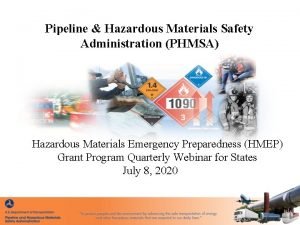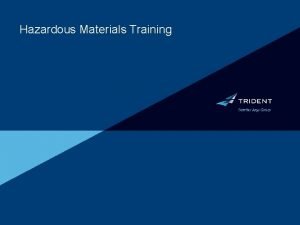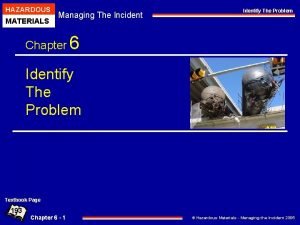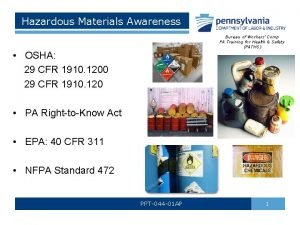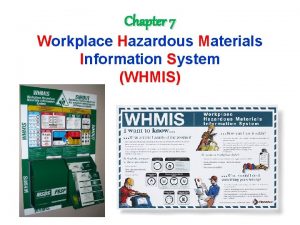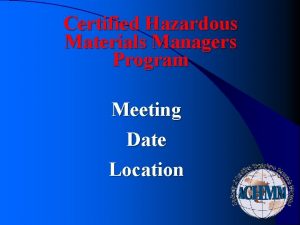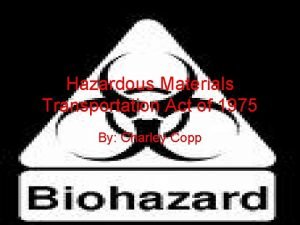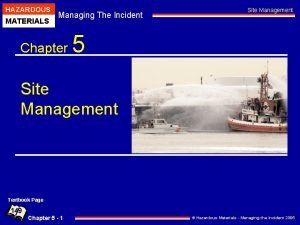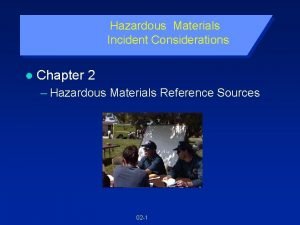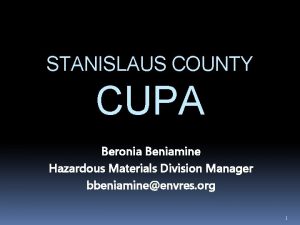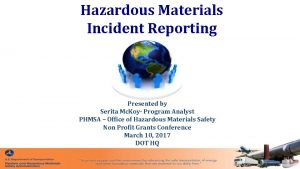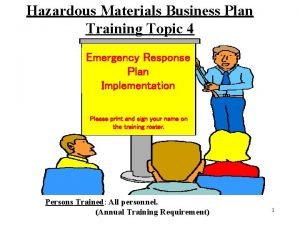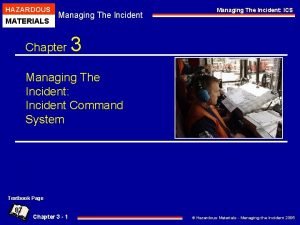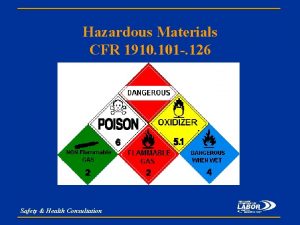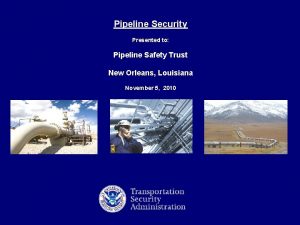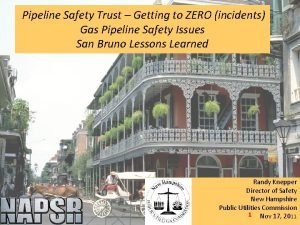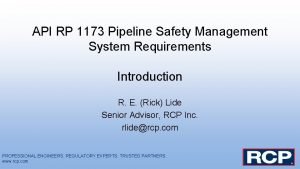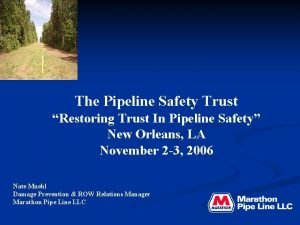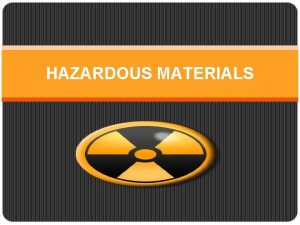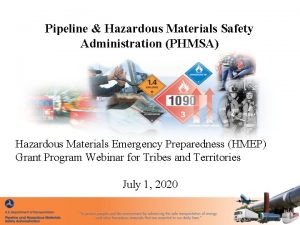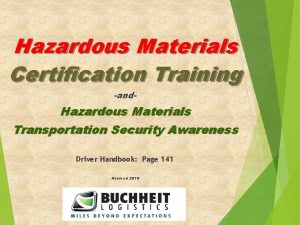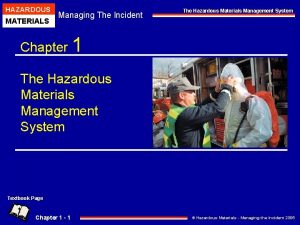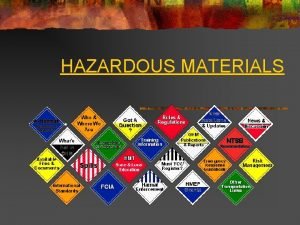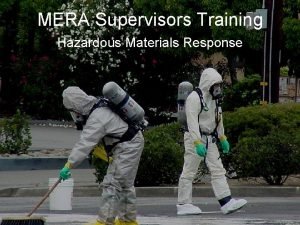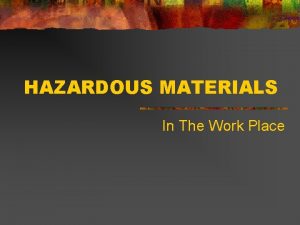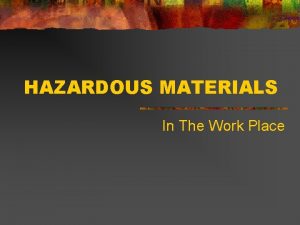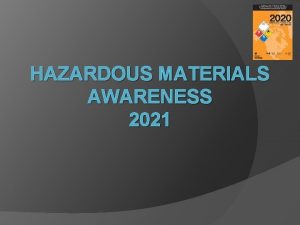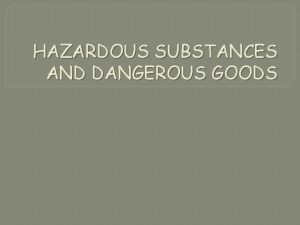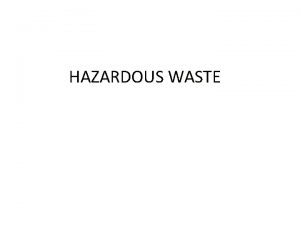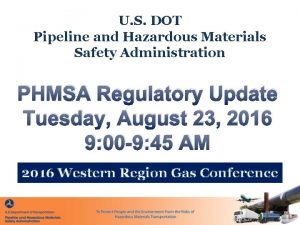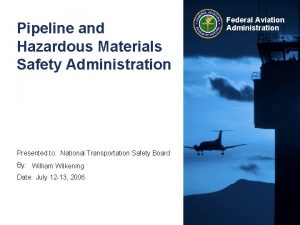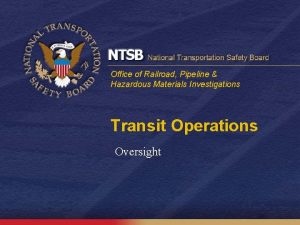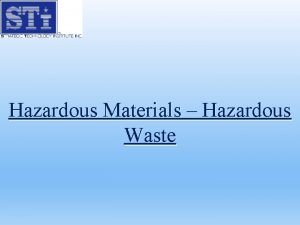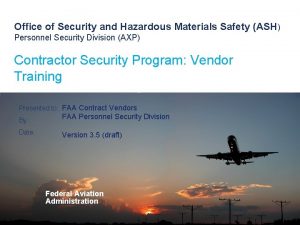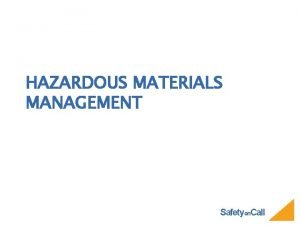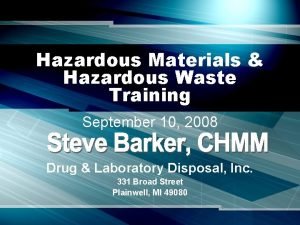Office of Pipeline Safety Pipeline and Hazardous Materials



























- Slides: 27

Office of Pipeline Safety Pipeline and Hazardous Materials Safety Administration Overview RRT 5 Spring 2018 Grand Rapids, MI Investigate – Analyze – Prevent

Objective • Introduce PHMSA • Establish an understanding how PHMSA can be a resource • Introduce PHMSA’s Accident Investigation Team National Pipeline Incident Coordinator (NPIC) – NPIC toll-free: (888) 719 -9033 • 811 Investigate – Analyze – Prevent

Who is the U. S. Department of Transportation (DOT) • • • National Highway Traffic Safety Administration (NHTSA) Federal Aviation Administration (FAA) Office of Inspector General (OIG) Federal Highway Administration (FHWA) Federal Motor Carrier Safety Administration (FMCSA) Federal Railroad Administration (FRA) Saint Lawrence Seaway Development Corporation (SLSDC) Federal Transit Administration (FTA) Maritime Administration (MARAD) • Pipeline and Hazardous Materials Safety Administration (PHMSA) – Office of Hazardous Materials – Office of Pipeline Safety Investigate – Analyze – Prevent

PHMSA (OPS) Pipeline role • PHMSA does not have response authority • Regulates interstate pipelines – Natural Gas – Hydrocarbons – Ammonia – Carbon Dioxide – And more Investigate – Analyze – Prevent

US DOT Regulated Pipelines in RRT 5 Investigate – Analyze – Prevent

PHMSA Reporting requirements • PHMSA has NRC reporting requirements for pipeline systems – Initial (within earliest practical moment following discovery but no later than 1 hour • Gas – An event involving a release of gas » A death, or personal injury necessitating in‐patient hospitalization » Greater than $50, 000 estimated property damage » Unintentional estimated gas loss of 3 million cubic feet or more – An event that results in an emergency shutdown of an LNG facility or natural gas storage facility – An event that is characterized as significant by operator • Hazardous Liquids – An event involving the release of a liquid » A death, or personal injury necessitating in‐patient hospitalization » Incident involved a fire or explosion » Greater than $50, 000 property damage including the cost of the cleanup, value of product » Resulted in pollution of any stream, river, lake, reservoir or similar body of water » An event that is characterized as significant by operator – 48‐hour • Must provide an update to confirm/revise initial information reported. Investigate – Analyze – Prevent

Available PHMSA OPS resources • Have agreements and partners with States to implement rules • PHMSA has PREP guidelines • PHMSA regulates pipeline operators readiness and response effectiveness • PHMSA has FRP repository for pipelines – Often fixed facilities are also regulated by EPA and/or USCG – Available to OSCs by request • Made up of primarily field staff – Highly technical – Engineers and Transportation Specialist Investigate – Analyze – Prevent

PHMSA Accident Investigation Division (AID) Motto: Investigate – Analyze – Prevent Established April 1, 2017

PHMSA Accident Investigation Division • PURPOSE – Evaluates all reports of incidents/accidents • Investigates all PHMSA regulated pipeline incidents – Consider details of report – Conducts Accident Investigations – Conducts Root Cause Determinations to determine casual and contributing factors to pipeline and liquefied natural gas facility incidents – Captures and actively shares lessons learned safety finding with internal and external stakeholders. – Conducts education and outreach to help advance pipeline safety – Evaluates and identify emerging safety trends – Coordinates incidents with state and federal partners Investigate – Analyze – Prevent

National Pipeline Incident Coordinator (NPIC) – NPIC toll-free: (888) 719 -9033 – PHMSAAccident. Investigation. Division@dot. gov – Staff Mobile Numbers: • • Peter Katchmar: 303‐ 807‐ 8458 Chris Ruhl: 405‐ 590‐ 3625 Brian Pierzina: 816‐ 589‐ 8293 Alex Colletti: 405‐ 403‐ 0541 Michael Jones: 405‐ 403‐ 0546 Darren Lemmerman: 816‐ 807‐ 2606 Gery Bauman: 440‐ 725‐ 7043 Julie Halliday: 202‐ 389‐ 2039 Investigate – Analyze – Prevent

Deployment Criteria A release of product and one or more of the following: �Death �Personal injury necessitating hospitalization �Property damage exceeding $500 K �Hazardous liquid spill of 500 or more barrels �Fire or explosion �Major spill into a body of water �Pipeline systems with recent failure history �Significant media attention �Release impacted: ‐ an HCA ‐ High Population Area ‐ Other Populated Areas ‐ Commercially navigable waterway, or major waterbody ‐ Unusually Sensitive Area (USA) ‐ (drinking water resource, ecological, threatened species) Investigate – Analyze – Prevent

Opportunities to work together • Pipeline FRPs • • • Preplanning RRTs PREP Drills • Incident coordination • Situational awareness • • • Common Operating Picture Leverage resources Pipeline mapping Operator Contacts and Coordination Evidence collection Investigate – Analyze – Prevent

Opportunities to work together Investigation • Equipment • Process • RP response effectiveness • Pipeline Operation • Training • Pipeline expertise Disaster Response • Pad set up and waste packaging • Hazmat transport waivers NTSB Investigation liaison • • • Investigate – Analyze – Prevent

NRS NOTIFICATION &DECISION PROCESS Incident Occurs Notification National Response Center Notification Natural Resources Trustees Notification On‐Scene Coordinator (OSC) Federal Response Required? PHMSA NRT YES RRTs Initial Assessment/ First Response Federal/State/Local/RP Notification Response Measures NO PHMSA Special Teams OSC Available to support OSC on request State/ Local/Tribal State/Local/RP Response RP (Unified Command Structure, as developed by the Area Committee) Investigate – Analyze – Prevent 14

Where does PHMSA’s role in ICS • Agency Representative • Operations – Investigation • Public Information Officer • Technical Specialist • Operates outside ICS Investigate – Analyze – Prevent

• • 8/7/17, Minneapolis, MN 3 rd Party Damage 100+ people evacuated (60 kids) Stub knocked off by bulldozer 3’ below grade. Pipeline was marked earlier in the day. Investigate – Analyze – Prevent

Natural Gas Pipeline Explosion Dixon, IL Occurred when agricultural equipment struck pipeline 2 fatalities, 2 injuries Investigate – Analyze – Prevent

Amherst, SD 5, 000 barrels of crude oil spilled Investigate – Analyze – Prevent EPA R 8 deployed

Solitude, Indiana 1400 barrels Diesel Investigate – Analyze – Prevent EPA R 5 Deployed

Investigate – Analyze – Prevent

PHMSA Regional Offices Investigate – Analyze – Prevent

Office of Hazardous Materials Central Region Field Operations Director Tyler Patterson (816) 329‐ 3815 Chief Investigator Tiffany Ziemer Investigator Mark Razny Investigator Tim Buffum Investigator Dan Richards Investigator Ted Turner Investigator Shirley Mcnew Investigator Mike Jennens Outreach and Engagement (HMSAT) Neal Suchak (202) 839‐ 0498; neal. Suchak@dot. gov Central Region Office, Kansas City, MO (816) 329‐ 3802 DOT Crisis Management Center: (202) 366‐ 1863 22

Hazardous Materials Accident Investigation Team Pilot Program

Background PHMSA’s Office of Hazardous Materials Safety initiated a root cause‐ based accident investigation pilot program to evaluate feasibility and viability of a full‐time accident investigation team. The Purpose for the pilot program: v. Become proactive instead of reactive towards accidents and their prevention v. Make safety recommendations to deter future accidents v. Track and respond quickly to emerging trends v. Establish specialized and recurrent root cause training for investigators 24

Objectives Ø Improving accuracy & relevance of PHMSA data collection efforts Ø Identifying emerging risks & recommending agency action (outreach & engagement, rulemaking, etc) Ø Developing safety recommendations Ø Establishing root case‐based accident training curriculum Ø Enhancing risk‐analysis through data‐driven, innovative tracking of emerging trends and near misses Ø Sharing accident data recommendations & lessons learned with internal & external stakeholders, including DOT modal partners 25

Pilot Benefits Ø Advancing quality of investigations by strengthening full‐ time investigator expertise through comprehensive root cause analysis training Ø Determining robust standardized processes to improve data collection, analysis & validation Ø Strengthening stakeholder outreach efforts & partnerships (OHMS, DOT modal partners, external stakeholders) 26

PHMSA Emergency Contact Information NPIC toll-free: (888) 719 -9033 PHMSAAccident. Investigation. Division@dot. gov DOT Crisis Management Center (202) 366 -1863 Investigate – Analyze – Prevent
 Pipeline and hazardous materials administration
Pipeline and hazardous materials administration Hazmat material table
Hazmat material table Hazardous materials table
Hazardous materials table Us military marking system for hazardous materials
Us military marking system for hazardous materials Hazwoper
Hazwoper Define whmis
Define whmis Certified hazardous materials manager
Certified hazardous materials manager Hazardous materials transportation act of 1975
Hazardous materials transportation act of 1975 Hazardous materials managing the incident
Hazardous materials managing the incident Hazardous materials reference books
Hazardous materials reference books Stanislaus county hazardous materials division
Stanislaus county hazardous materials division Hazardous materials incident report
Hazardous materials incident report Hazardous materials business plan
Hazardous materials business plan Hazardous materials managing the incident
Hazardous materials managing the incident Osha 1910 psm
Osha 1910 psm Difference between linear and nonlinear pipeline processors
Difference between linear and nonlinear pipeline processors Pipeline vs superscalar
Pipeline vs superscalar Natural materials
Natural materials Material that useful and harmful
Material that useful and harmful Natural materials and man made materials
Natural materials and man made materials Adopting and adapting teaching materials
Adopting and adapting teaching materials Solid and hazardous waste
Solid and hazardous waste Pipeline safety trust
Pipeline safety trust Pipeline safety trust
Pipeline safety trust Api 1173 pipeline safety management systems
Api 1173 pipeline safety management systems Pipeline safety trust
Pipeline safety trust Direct materials budget with multiple materials
Direct materials budget with multiple materials Difference between office location and office layout
Difference between office location and office layout
